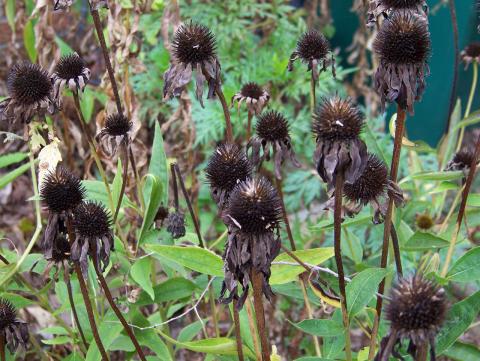Should perennials be cut back in fall?

The first task most gardeners consider when preparing the garden for winter is cutting back perennials. While thoroughly clipping back and cleaning up the garden in the fall may save some time in the spring, there are benefits to leaving certain plants standing from both ecological and aesthetic perspectives.
Perennials that supply food for birds
Though cutting everything to the ground may give the garden a tidy look, it does a disservice to wildlife species that can make use of some plants in the winter. Leaving perennial seed heads provides natural foraging habitat for native wildlife. In the winter months when food is scarce, gardens full of withered fruit and dried seed heads can provide birds with a reliable food source. Seed-eating songbirds such as finches, sparrows, chickadees, juncos and jays will make use of many common garden plants. When cleaning up the garden, prioritize removing and discarding diseased top growth, but leave healthy seed heads standing. Old stalks and leaves can be cut back in the spring before new growth begins.
Plants to leave standing in the garden include purple coneflowers (Echinacea), black-eyed susan (Rudbeckia), coreopsis (Coreopsis), sunflower (Heliopsis), prairie gay feather (Liatris), switchgrass (Panicum virgatum) and little blue stem (Schizachyrium scoparium).
Perennials that provide winter interest
Beyond providing habitat, limiting fall clean-up can also provide winter interest in the garden. Dried stalks, seedpods and leaves add a different dimension to the garden once the snow begins to fall. In particular, ornamental grasses add color, movement and texture to the winter landscape. Switchgrass, Chinese silver grass (Miscanthus sinensis) and feather reed grass (Calamagrostis x acutiflora) are typically left standing until spring. Some gardeners also enjoy the look of blackened seedpods of false indigo (Baptisia) or sea holly (Eryngium). It is also unnecessary to clip back perennials with evergreen foliage such as hellebore (Helleborus) and Christmas fern (Polystichum acrostichoides) until the spring. These plants can be tidied up once new growth begins in the spring.
Perennials that need winter protection
Many marginally hardy perennials are much more likely to survive the winter if the dead plant stems are not removed until the spring. Dead stems can trap leaves and snow around the crown of the plant, which provide insulation and extra protection from cold temperatures. Garden mums (Chrysanthemum), anise hyssop (Agastache foeniculum) and Nippon daisy (Nipponanthemum nipponicum) profit from spring, rather than fall, cutting. It’s also easier to remember where late-rising perennials are located in the spring when the stems are standing and thus avoid accidentally digging in that spot.
Perennials to cut
Plants that do not provide many benefits to wildlife or winter interest can be cut back in the fall to reduce labor in the spring. Good examples include iris (Iris), daylilies (Hemerocallis), hosta (Hosta), astilbe (Astilbe), peony (Paeonia), yarrow (Achillea), lungwort (Pulmonaria), Shasta daisy (Leucanthemum x superbum) and garden phlox (Phlox paniculata). Additionally, anything that was diseased should be removed from the garden. Beebalm (Monarda) and garden phlox (Phlox paniculata) often become infected with powdery mildew toward the end of the growing season. Disease issues the following year can be significantly reduced by removing as much infected material from the garden as possible. Many fungal diseases can overwinter in plant debris and cause infections the following year when growing conditions are right. Avoid composting diseased plant material because most backyard compost piles do not get hot enough to kill pathogens.
Leaving perennials standing throughout the winter may create a little more work in the spring, but may, in turn, increase wildlife value, beauty and plant survival—things every gardener can appreciate.
Got questions? The Ask UNH Extension Infoline offers practical help finding answers for your home, yard, and garden questions. Call toll free at 1-877-398-4769, Monday to Friday, 9 a.m. to 2 p.m., or e-mail us at answers@unh.edu.
Related Resource(s)
Do you love learning about stuff like this?
SUBSCRIBE TO Granite State Gardening newsletter
Got questions? The UNH Extension Yard and Garden Infoline offers practical help finding answers for your yard and garden questions.
Call toll free at 1-877-398-4769, Monday to Friday, 9 a.m. to 2 p.m., or fill out webform.
